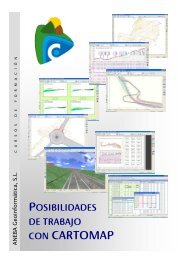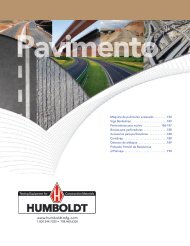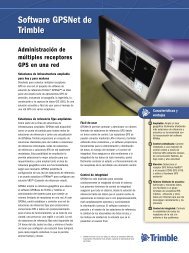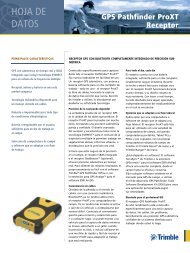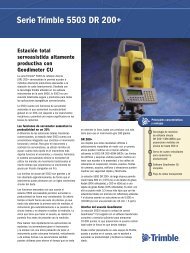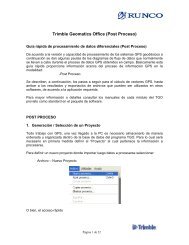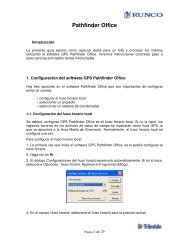GNSS Choke Ring Antenna - Accupoint
GNSS Choke Ring Antenna - Accupoint
GNSS Choke Ring Antenna - Accupoint
- No tags were found...
Create successful ePaper yourself
Turn your PDF publications into a flip-book with our unique Google optimized e-Paper software.
Trimble Geodetic <strong>Antenna</strong>s–A solution for every application<strong>GNSS</strong> GEODETICANTENNAS
Trimble geodetic antennas mitigate multipath in different ways. Both providethe accuracy and performance required for the most rigorous applications.TRIMBLE gnss GEODETIC ANTENNAS—NOW YOU HAVE A CHOICETWO PROVEN ANTENNAS TO ACHIEVE GEODETIC ACCURACY ANDLONG-TERM PERFORMANCECritical to the value of any <strong>GNSS</strong> network are the antennas that keep constantwatch on <strong>GNSS</strong> satellite signals. Trimble geodetic antennas provide networkoperators with the assurance of long-term operation and unsurpassedperformance.Trimble offers two styles of antennas designed for geodetic applications—theTrimble Zephyr Geodetic 2 <strong>Antenna</strong> and the Trimble <strong>GNSS</strong> <strong>Choke</strong> <strong>Ring</strong> <strong>Antenna</strong>.Both options are proven to deliver the exacting performance that networkoperators demand to ensure long-term success. In addition, two unique antennadesigns provide the flexibility to reach a wide range of operational goals.Trimble <strong>GNSS</strong> <strong>Choke</strong> <strong>Ring</strong> <strong>Antenna</strong>Trimble Zephyr Geodetic 2 <strong>Antenna</strong>SETTING THE GEODETIC STANDARDAll Trimble <strong>GNSS</strong> geodetic antennas conform to strict standards of consistency andperformance to deliver the best possible low elevation tracking.Trimble geodetic antennas meet or exceed phase-center eccentricity standards of2 mm, and offer industry-leading multipath mitigation. Trimble’s geodetic-qualityantennas maximize positioning performance and consistency through tightlycontrolledmanufacturing practices, extensive testing and innovative engineering.WHICH ANTENNA IS RIGHT FOR YOU?The choice of what kind of antenna you ultimately choose is driven by your operational needs. Depending upon yourpriorities, it may become clear that one antenna style is a better fit for your particular application. For example, are yourunning a network or performing a geodetic campaign? Does an external organization dictate the antenna style that youmust use? Are size and weight important considerations for installation or long-term deployment? Although there are manydifferent factors to consider and evaluate before making this important decision, Trimble has a solution that will meet yourprecise needs.
TRIMBLE <strong>GNSS</strong> CHOKE RING ANTENNAOriginally conceived in the mid 1980s, the choke ring’s groundplane has been widely adopted by the scientific community. TheTrimble <strong>GNSS</strong> choke ring ground plane uses the Jet PropulsionLabs (JPL) design, which is considered the standard of scientificgeodetic antenna ground planes. In addition to updating theelectronics to improve low-noise amplification and <strong>GNSS</strong> tracking,Trimble has modernized the <strong>GNSS</strong> choke ring antenna so that itcan track all existing and proposed public <strong>GNSS</strong> constellations.These include GPS, GLONASS, Galileo and Compass.The Trimble <strong>GNSS</strong> <strong>Choke</strong> <strong>Ring</strong> antenna includes a TrimbleexclusiveDorne & Margolin quad-dipole element. A standard bywhich all other geodetic antennas are judged, the D & M elementserves as the control in published relative antenna models. Thedesign is also proven to offer excellent long term stability.To ensure the best possible performance, Trimble requires thatthe element manufacturer conduct supplemental performancetesting and provide proof of passing on all Trimble <strong>GNSS</strong> <strong>Choke</strong><strong>Ring</strong> antenna elements. As a final step to guarantee geodeticperformance, all assembled choke ring antennas undergoadditional Trimble-exclusive precision rotation testing to verify aphase-center eccentricity of no more than 2 mm. Every Trimble<strong>GNSS</strong> <strong>Choke</strong> <strong>Ring</strong> antenna comes with a certificate displaying therotation test results specific to that antenna.TRIMBLE ZEPHYR GEODETIC 2 ANTENNAIn the years following the launch of the choke ring antenna,Trimble developed an alternative means to achieving geodeticqualityresults. Design goals included increasing accuracy andeliminating the frequency-dependent ground plane design. Firstproduced in 2001, the GPS-capable Trimble Zephyr Geodeticantenna is the high-performance result of these efforts.Then, in 2006, Trimble released the next generation with the<strong>GNSS</strong>-capable Zephyr Geodetic 2 antenna. Consistently deliveringphase-center eccentricities of less than 1 mm, the ZephyrGeodetic 2 antenna’s performance guarantees that even in alarge network, all stations will be capable of delivering accurate,repeatable measurements. This is not the only advanced featureof the Trimble Zephyr Geodetic 2 antenna—it also offers theunique Trimble Stealth ground plane. This resistive groundplane consumes unwanted signals before they can reach thereceiving element and corrupt measurements. This modern, hightechnologyapproach to multipath mitigation is more compactthan the original choke ring design and allows for the use of anintegrated, low-profile radome over the entire antenna elementand ground plane assembly. The Trimble Zephyr Geodetic 2antenna’s design reduces wind loading and antenna weightso that a lighter mounting structure can offer geodetic-qualityresults while minimizing environmental impact.Yet another benefit of the Stealth ground plane is its frequencyindependentperformance. It mitigates unwanted signalsthroughout the rapidly-expanding <strong>GNSS</strong> spectrum.The Trimble Zephyr Geodetic 2 antenna is designed to receiveall existing and proposed public <strong>GNSS</strong> signals, including GPS,GLONASS, Galileo and Compass. In addition, these antennas areused in the highest-accuracy IGS reference frame networks whereonly the best possible long-term performance is accepted.Proper <strong>Antenna</strong> PlacementGeodetic antennas are designed to provide accuratemeasurements even in imperfect conditions, but this does notmean that a geodetic antenna will give peak performanceno matter where it is deployed. Therefore, selecting the bestpossible location for a reference antenna is very importantbecause the measurements will be relied upon for many years.
trimble <strong>GNSS</strong> Geodetic ANteNNASMANAGING MULTIPATHThe extended ground plane of a geodetic antenna isintended to stop all multipath signals that come fromnear or below the horizon. These unwanted signals oftenreflect off of more than one surface and many have righthandcircular polarization (RHCP) characteristics that theantenna will readily accept. With a conventional metal diskground plane, unwanted signals can actually strike the topof the ground plane, or its edge, at a shallow angle. Thosesignals then propagate along the surface of the plane andare easily conducted directly into the receiving element.This is called a surface wave. An effective geodetic groundplane must block below-horizon signals from entering theelement while also prohibiting surface waves.Trimble’s JPL-designed choke ring and Stealth ground planesboth accomplish these tasks, but in very different ways. Thechoke ring antenna reflects signals that come from below.For signals that would otherwise be captured as surfacewaves, the choke ring draws these signals into the chokechannels where they repeatedly reflect and encounter otherreflected signals until they lose all energy or are reflectedaway from the receiving element.The Trimble Stealth ground plane uses electrical resistancerather than frequency-tuned rings to keep unwantedsignals from reaching the antenna element. With itsresistive ground plane, signals that strike the plane fromany direction are drawn into the Stealth plane. Here, theyencounter increasing electrical resistance, which rapidlyconverts their radio energy into tiny amounts of harmlessheat. The signals lose all energy before they can reach theelement and cause interference.GROUND PLANES ANDMULTIPATH SIGNALS• Signals striking at shallow anglesattempt to create surface waves• Signals from below the horizonmust be eliminated1) <strong>Choke</strong> <strong>Ring</strong> weakens multipath signals 2) Zephyr Geodetic 2 consumes multipath signalsDesirable signals are shown in green; undesirable signals are shown in red.The following are very basic requirements for an antennainstallation. Note that some governing bodies requiresignificant additional features in an antenna monumentand its location.• The antenna mount must be stable in changing weatherconditions and temperatures. By definition, a referenceantenna should not move.• The antenna sky view should be clear to the horizonwithin a 100 m radius to reduce multipath signalinterference.• The antenna should be a minimum of 1.5 m above nearbysignal reflectors to reduce multipath signal interference.• There should not be any high-power transmittingantennas within 300 m to prevent RF interference.
NORTH AMERICATrimble Engineering andConstruction Group5475 Kellenburger RoadDayton, Ohio 45424-1099USA800-538-7800 (Toll Free)+1-937-245-5154 Phone+1-937-233-9441 FaxEUROPETrimble GmbHAm Prime Parc 1165479 RaunheimGERMANY+49-6142-2100-0 Phone+49-6142-2100-550 FaxAFRICA & MIDDLE EASTTrimble Export Middle-EastP.O. Box 17760Jebel Ali Free ZoneDubaiUAE+971-4-881-3005 Phone+971-4-881-3007 FaxASIA-PACIFICTrimble NavigationSingapore PTE Limited80 Marine Parade Road#22-06, Parkway ParadeSingapore 449269SINGAPORE+65-6348-2212 Phone+65-6348-2232 Faxwww.trimble.com© 2008, Trimble Navigation Limited. All rights reserved. Trimble and the Globe & Triangle logo are trademarks of Trimble Navigation Limited,registered in the United States and in other countries. Stealth, Zephyr, and Zephyr Geodetic are trademarks of Trimble Navigation Limited. All othertrademarks are the property of their respective owners. PN 022543-429 (04/08)CHINATrimble BeijingRoom 2602-05Tengda PlazaNo. 168 Xiwai StreetHaidian District, BeijingCHINA 100044+86-10-8857-7575 Phone+86-10-8857-7161 Faxwww.trimble.com.cn



